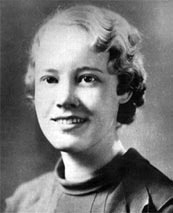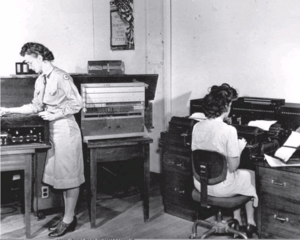Genevieve Grotjan Feinstein facts for kids
Quick facts for kids
Genevieve Grotjan Feinstein
|
|
|---|---|
 |
|
| Born |
Genevieve Marie Grotjan
April 30, 1913 |
| Died | August 10, 2006 (aged 93) |
| Citizenship | American |
| Known for | Deciphering the Purple machine |
| Spouse(s) | Hyman Feinstein |
| Scientific career | |
| Fields | Mathematics Cryptanalysis |
| Institutions | Signals Intelligence Service |
Genevieve Marie Grotjan Feinstein (April 30, 1913 – August 10, 2006) was an American mathematician and cryptanalyst. She worked for the Signals Intelligence Service throughout World War II, during which time she played an important role in deciphering the Japanese cryptography machine Purple, and later worked on the Cold War-era Venona project.
Career
Feinstein discovered a passion for mathematics at a young age and aspired to become a math teacher. She graduated from the University at Buffalo summa cum laude in February 1936 with a mathematics degree. Unable to find a teaching job, she took a position as a statistical clerk at the Railroad Retirement Board. Her high score on a civil service mathematics test in 1939 got the attention of William F. Friedman, who hired her to work as a junior cryptanalyst for the Army's Signals Intelligence Service (SIS). For eighteen months, she worked with other SIS codebreakers to analyze the encryption system used in the Japanese Type B Cipher Machine, code named Purple by the SIS She played a key role in cracking the cipher, discovering cyclical behavior in the code on September 20, 1940. This enabled the construction of an equivalent machine by the SIS which in turn enabled the interception of almost all messages exchanged between the Japanese government and its embassies in foreign countries. Purple-encoded reports from Hiroshi Oshima, the Japanese ambassador in Berlin, were a main source of intelligence about Axis plans.
In 1946, she was awarded the Exceptional Civilian Service Award from Brig. Gen. Paul Everton Peabody for her wartime service.
She was later assigned to the Venona project, trying to decode encrypted messages sent by the Soviet KGB and Main Intelligence Directorate (GRU). She made a significant breakthrough in November 1944, which allowed American cryptographers to recognize when an individual one time pad cipher was (improperly) reused. After the conclusion of World War II, Feinstein continued to work at the SIS, as the Cold War began, but resigned in 1947. After resigning from government cryptanalysis, she joined the faculty of George Mason University, where she served as a professor of mathematics.
Personal life
Genevieve Grotjan married the chemist Hyman Feinstein, a chemist at the National Bureau of Standards in 1943, and they had a son named Ellis, who died of a heart condition at age 22. Grotjan died in 2006.
Legacy
Feinstein's breakthrough in deciphering the Purple machine has been called, in the Encyclopedia of American Women at War, "one of the greatest achievements in the history of U.S. codebreaking". She was posthumously inducted into the NSA Hall of Honor in 2010, and an award in cryptology was established at George Mason University in her honor.
In 2018, the University at Buffalo featured her as "An American Hero".


